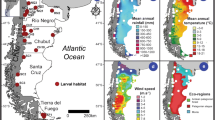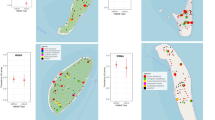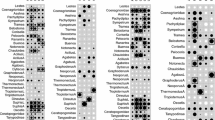Abstract
Distributions of mosquito larvae likely are a consequence of multiple factors, although two commonly studied factors (quality of the larval environment and the terrestrial matrix in which these habitats reside) have rarely and simultaneously been varied in the field to understand distributions of larvae. We monitored aquatic containers of two leaf detritus levels within a forest, prairie, and industrial habitat across five months to understand the temporal and spatial colonization of aquatic invertebrates in Northcentral Illinois, USA. Data were collected monthly on mosquito populations and the composition of other invertebrates colonizing containers. Overall, six species of mosquitoes colonized containers, with Culex restuans and Aedes triseriatus having the highest relative abundances. There were strong seasonal abundance patterns for these two mosquito species, with the dominant species changing over time in the forest habitat. The responses of other mosquito taxa were more variable, with abundances reflective of either the terrestrial matrix or larval habitat quality. High detritus containers supported the highest abundances of most species encountered, regardless of habitat. Non-mosquito taxa were less common numerically, but analyses suggested that some taxa, such as syrphid larvae, often co-occurred with mosquitoes. Nested subset analysis indicated communities were strongly nested, and that both habitat type and detritus level were important in explaining nested patterns of aquatic invertebrates. Our data show that both the larval habitat and the surrounding terrestrial matrix shape patterns of container mosquitoes, and that other container invertebrates vary in similar ways as mosquitoes.



Similar content being viewed by others
References
Barker, C. M., C. C. Brewster & S. L. Paulson, 2003. Spatiotemporal oviposition and habitat preference of Aedes triseriatus and Aedes albopictus in an emerging focus of La Crosse virus. Journal of the American Mosquito Control Association 19: 382–391.
Barrera, R., 1988. Multiple factors and their interactions on structuring the community of aquatic insects of treeholes. Ph.D. Dissertation, The Pennsylvania State University, Pennsylvania.
Beier, J.C., C. Patricoski, M. Travis & J. Kranzfelder, 1983. Influence of water chemical and environmental parameters on larval mosquito dynamics in tires. Environmental Entomology 12: 434–438.
Bentley, M. D. & J. F. Day, 1989. Chemical ecology and behavioral aspects of mosquito oviposition. Annual Review of Entomology 34: 401–421.
Benzon, G. L. & C. S. Apperson, 1988. Reexamination of chemically mediated oviposition behavior of Aedes aegypti (L.) (Diptera: Culicidae). Journal of Medical Entomology 25: 158–164.
Berry, W. J. & G. B. Craig Jr., 1984. Bionomics of Aedes atropalpus breeding in scrap tires in northern Indiana. Mosquito News 44: 476–484.
Blaustein, L., M. Kiflawi, A. Eitam, M. Mangel & J. E. Cohen, 2004. Oviposition habitat selection in response to risk of predation in temporary pools: mode of detection and consistency across experimental venue. Oecologia 138: 300–305.
Bradshaw, W. E. & C. M. Holzapfel, 1992. Resource limitation, habitat segregation, and species interactions of British tree-hole mosquitoes in nature. Oecologia 90: 225–237.
Carpenter, S. R., 1983. Resource limitation of larval treehole mosquitoes subsisting on beech detritus. Ecology 64: 219–223.
Clark, K. R. & R. M. Warwick, 1994. Change in Marine Communities: An Approach to Statistical Analysis and Interpretation. Natural Environment Research Council, UK.
Clements, A. N., 1999. The Biology of Mosquitoes, Vol. II. Chapman & Hall, London.
Copeland, R. S. & G. B. Craig Jr., 1990. Habitat selection among treehole mosquitoes (Diptera: Culicidae) in the Great Lakes Region of the Unites States. Annals of the Entomological Society of America 83: 1063–1073.
Daugherty, M. P. & S. A. Juliano, 2002. Testing for the context-dependence in a processing chain interaction among detritus-feeding aquatic insects. Ecological Entomology 27: 541–553.
Daugherty, M. P., B. W. Alto & S. A. Juliano, 2000. Invertebrate carcasses as a resource for competiting Aedes albopictus and Aedes aegypti (Diptera: Culicidae). Journal of Medical Entomology 37: 364–372.
Eisenberg, J. N. S., J. O. Washburn & S. J. Schreiber, 2000. Generalist feeding behaviors of Aedes sierrensis larvae and their effects on protozoan populations. Ecology 81: 921–935.
Eitam, A. & L. Blaustein, 2004. Oviposition habitat selection by mosquitoes in response to predator (Notonecta maculata) density. Physiological Entomology 29: 188–191.
Fish, D. & S. R. Carpenter, 1982. Leaf litter and larval mosquito dynamics in tree-hole ecosystems. Ecology 63: 283–288.
Frank, J. H. & L. P. Lounibos, 1983. Phytotelmata: Terrestrial Plants as Hosts for Aquatic Insect Communities. Plexus Publishing, Inc., NJ.
Haramis, L. D., 1984. Aedes triseriatus: a comparison of density in tree holes vs. discarded tires. Mosquito News 44: 485–489.
Hatcher, L. & E. J. Stepansky, 1994. A Step by Step Approach to Using SAS System for Univariate and Multivariate Analyses. SAS Institute Inc., NC.
Honnay, O. & M. Hermy, 2000. Nested subset analysis as a tool for characterizing plant community composition in Flemish woodlands. Proceedings IAVS Symposium, 357–360.
Jenkins, B., R. L. Kitching & S. L. Pimm, 1992. Productivity, disturbance and food web structure at a local spatial scale in experimental container habitats. Oikos 65: 249–255.
Juliano, S. A., 1998. Species introduction and replacement among mosquitoes: interspecific resource competition or apparent competition? Ecology 79: 255–268.
Kitching, R. L., 2000. Food Webs and Container Habitats. The Natural History and Ecology of Phytotelmata. Cambridge University Press, Cambridge, UK.
Kitching, R. L., 2001. Food webs in phytotelmata: “bottom-up” and “top-down” explanations for community structure. Annual Review of Entomology 46: 729–760.
Kodric-Brown, A. & J. H. Brown, 1993. Highly structured fish communities in Australian desert springs. Ecology 74: 1847–1855.
Lampman, R., S. Hanson & R. Novak, 1997. Seasonal abundance and distribution of mosquitoes at a rural waste tire site in Illinois. Journal of the American Mosquito Control Association 13: 193–200.
Lee, J. H. & W. A. Rowley, 2000. The abundance and seasonal distribution of Culex mosquitoes in Iowa during 1995–1997. Journal of the American Mosquito Control Association 16: 275–278.
Léonard, P. M. & S. A. Juliano, 1995. Effect of leaf litter and density on fitness and populations performance of the tree hole mosquito Aedes triseriatus. Ecological Entomology 20: 125–136.
Lounibos, L. P., N. Nishimura & R. L Escher, 1993. Fitness of a treehole mosquito: influences of food type and predation. Oikos 66: 114–118.
Lundkvist, E., J. Landin, M. Jackson & C. Svensson, 2003. Diving beetles (Dytiscidae) as predators of mosquito larvae (Culicidae) in field experiment and in laboratory tests of prey preference. Bulletin of Entomology Research 93: 219–226.
Mayhew, P. J., 2001. Herbivore host choice and optimal bad motherhood. Trends in Ecology and Evolution 16: 165–167.
Maw, M. G., 1970. Capric acid as a larvacide and an oviposition stimulant for mosquitoes. Nature 227: 1154–1155.
Paradise, C. J., 1999. Interactive effects of resources and a processing chain interaction in treehole habitats. Oikos 85: 529–535.
Paradise, C. J. & W. A. Dunson, 1998. Effects of sodium concentration on Aedes triseriatus (Diptera: Culicidae) and microorganisms in treeholes. Journal of Medical Entomology 35: 839–844.
Patterson, B. D. & W. Atmar, 1986. Nested subsets and the structure of insular mammalian faunas and archipelagos. In Heaney, L. R. & B. D. Patterson (eds), Island Biogeography of Mammals. Academic Press, London, 65–82.
Reiskind, M. H. & M. L. Wilson, 2004. Culex restuans (Diptera: Culicidae) oviposition behavior determined by larval habitat quality and quantity in Southeastern Michigan. Journal of Medical Entomology 41: 179–186.
SAS Institute Inc., 2004. SAS/STAT® 9.1 User’s Guide. SAS Institute Inc., NC, USA.
Scheiner, S. M., 2001. MANOVA. Multiple response variables and multi species interactions. In Scheiner, S. M. & J. Gurevitch (eds), Design and Analysis of Ecological Experiments, 2nd edn. Oxford University Press, Oxford, 99–133.
Scheirs, J. & L. De Bruyn, 2002. Integrating optimal foraging and optimal oviposition theory in plant-insect research. Oikos 96: 187–191.
Simberloff, D. & B. Levin, 1985. Predictable sequences of species loss with decreasing island area – land birds in two archipelagos. New Zealand Journal of Ecology 8: 11–20.
Trexler, J. D., C. S. Apperson, L. Zurex, C. Gemeno, C. Schal, M. Kaufman, E. Walker, D. W. Watson & L. Wallace, 2003. Role of bacteria in mediating the oviposition responses of Aedes albopictus (Diptera: Culicidae). Journal of Medical Entomology 40: 841–848.
Yee, D. A. & S. A. Juliano, 2006. Consequences of detritus type in an aquatic microsystems: assessing water quality, micro-organisms, and the performance of the dominant consumer. Freshwater Biology 51: 448–459.
Yee, D. A. & S. A. Juliano, 2007. Abundance matters. A field experiment testing the more individuals hypothesis for richness-productivity relationships. Oecologia (in press).
Walker, E. D., M. G. Kaufman, M. P. Ayres, M. H. Riedel & R. W. Merritt, 1997. Effects of variation in quality of leaf detritus on growth of the eastern tree-hole mosquito, Aedes triseriatus (Diptera: Culicidae). Canadian Journal of Zoology 75: 706–718.
Wilton, D. P., 1968. Oviposition site selection by the tree-hole mosquito, Aedes triseriatus (Say). Journal of Medical Entomology 5: 189–194.
Worthen, W. B., 1996. Community composition and nested-subset analyses: basic descriptors for community ecology. Oikos 76: 417–426.
Worthen, W. B., M. L. Carswell & K. A. Kelly, 1996. Nested subset structure of larval mycophagous assemblages: nestedness in a non-island system. Oecologia 107: 257–264.
Wright, D. H. & J. H. Reeves, 1992. On the meaning and measurement of nestedness of species assemblages. Oecologia 92: 416–428.
Wright, D. H., B. D. Patterson, G. M. Mikkelson, A. Cutler & W. Atmar, 1998. A comparative analysis of nested subset patterns of species composition. Oecologia 113: 1–20.
Acknowledgements
We thank S. A. Juliano and two anonymous reviewers for comments on an earlier manuscript. We also thank the staff at the Midewin National Tallgrass Prairie for allowing us to conduct this research, and especially C. J. Whelan for providing logistic support which was vital to the completion of this project. This work was supported by grants from the National Institutes of Allergy and Infectious Disease to D. A. Yee (R15 AI51374-01A1) and S. A. Juliano (R15 AI51374-01A1 and R01 AI-44793). This research was conducted by S. H. Yee independent of U.S. E.P.A. employment, and the conclusions are solely those of the authors, and not necessarily the Agency.
Author information
Authors and Affiliations
Corresponding author
Additional information
Handling editor: K. Martens
Rights and permissions
About this article
Cite this article
Yee, D.A., Yee, S.H. Nestedness patterns of container-dwelling mosquitoes: effects of larval habitat within variable terrestrial matrices. Hydrobiologia 592, 373–385 (2007). https://doi.org/10.1007/s10750-007-0775-6
Received:
Revised:
Accepted:
Published:
Issue Date:
DOI: https://doi.org/10.1007/s10750-007-0775-6




